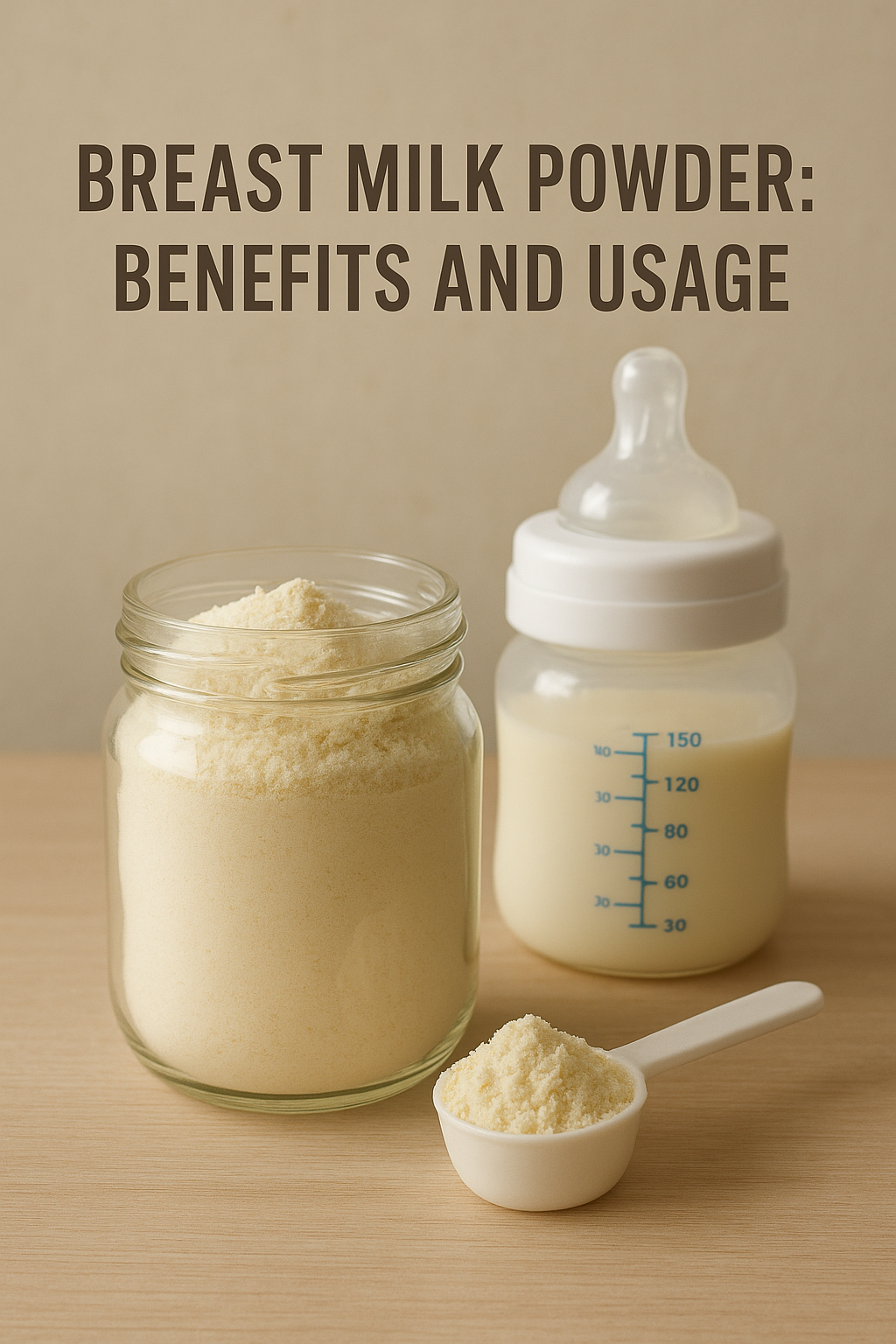
Breast Milk Powder: Benefits and Usage
Share
Breastfeeding provides babies with optimal nutrition, immune support, and essential growth factors. However, many parents face challenges with storage, travel, or maintaining a consistent milk supply. This is where breast milk powder becomes a practical solution. Freeze-dried or powdered breast milk allows parents to preserve the natural nutrients of breast milk while offering the convenience of easy storage, transport, and rehydration. Unlike formula, powdered breast milk retains many of the bioactive compounds, antibodies, and natural flavors of fresh milk, supporting the baby’s development.
Whether you are returning to work, traveling, or simply seeking a backup supply, powdered breast milk provides flexibility without compromising nutrition. Understanding how to store, rehydrate, and use powdered milk safely ensures both convenience and continued health benefits for your baby.
Benefits of Breast Milk Powder
- Convenient Feeding – Powdered breast milk can be prepared in minutes, making night feeds, travel, or daycare routines simpler. It eliminates the need to constantly pump and refrigerate fresh milk.
- Maintains Milk Nutrition – Freeze-drying preserves many essential nutrients, vitamins, and immune components found in fresh breast milk. Babies continue to receive the benefits of naturally produced milk even when fresh milk isn’t immediately available.
- Extended Shelf Life – Unlike fresh milk, powdered breast milk can be stored at room temperature for longer periods, reducing waste and providing peace of mind for parents.
- Easy Storage and Transport – Powdered milk requires less space than frozen milk and can be easily carried for trips, work, or emergencies. It is also less prone to spoilage during transport.
- Supports Consistent Supply – Parents struggling with milk production can rely on freeze-dried milk as a supplement, ensuring babies always receive breast milk even if pumping sessions are missed.
For more information on breast milk storage, you can visit Breast Milk Storage.
How to Store and Rehydrate Powdered Breast Milk
- Proper Storage – Store unopened powdered milk in a cool, dry place, away from direct sunlight. Once opened, transfer to an airtight container and use within the recommended period.
- Rehydration – Mix the powder with clean, lukewarm water according to the instructions on the package. Shake gently to avoid clumping. Always test the temperature before feeding your baby.
- Hygiene Matters – Wash hands and sterilize feeding bottles before preparing rehydrated milk. Proper hygiene ensures safety and prevents contamination.
- Use Promptly After Rehydration – Similar to fresh milk, rehydrated powdered breast milk should be used within 2 hours if kept at room temperature, or within 24 hours if refrigerated. Never refreeze rehydrated milk. For step-by-step guidance, check Freeze-Dried Breast Milk Powder.
Shelf Life and Nutritional Value
-
Long Shelf Life – When stored in a cool, dry place and unopened, powdered breast milk can last several months, depending on manufacturer guidelines.
-
Retention of Key Nutrients – Freeze-drying preserves most of the milk’s natural nutrients, including essential proteins, healthy fats, vitamins, and antibodies that support the baby’s growth and immune system.
-
Check for Expiration – Always note the expiration date on the packaging to ensure safety. Using milk past its expiry may reduce nutritional quality and safety.
-
Signs of Compromise – Avoid using powder that shows moisture, clumping, discoloration, or an unusual odor, as these indicate possible spoilage.
-
Safe Storage Practices – Store in an airtight container after opening and keep it away from sunlight, heat, and humidity to maintain nutritional integrity.
- Rehydration Timing – Once rehydrated, milk should ideally be used within 24 hours when refrigerated and never refrozen to ensure optimal nutrition.
Tips for Using Powdered Breast Milk
-
Measure Accurately – Always follow the manufacturer’s instructions for the correct powder-to-water ratio. Accurate measurement ensures your baby receives the proper nutrients and prevents over-dilution or concentration.
-
Feed Safely – Check that the milk is at an appropriate temperature before feeding. Lukewarm milk (~37°C) is ideal. For guidance on warming and safe feeding, see Milk Temperature for Baby.
-
Rotate Stock – Use older powder first to prevent wastage. Keeping track of expiration dates ensures your baby receives safe and fresh milk.
-
Supplement Smartly – Powdered breast milk can support breastfeeding or act as a convenient backup. It should not completely replace fresh milk unless necessary, as fresh milk provides live enzymes and additional immune benefits.
-
Track Intake – Maintain a feeding log to monitor your baby’s consumption and nutritional intake. Tools like Baby Milk Calculator can help ensure proper feeding amounts and schedules.
-
Rehydrate Properly – Use clean, safe water at the recommended temperature for mixing. Stir or shake gently to dissolve powder completely and avoid lumps.
-
Store Prepared Milk Carefully – Once rehydrated, store milk in the fridge and use within 24 hours. Never refreeze rehydrated milk to maintain safety and nutrient quality.
- Maintain Hygiene – Always wash hands and sanitize bottles or feeding equipment before preparing milk to reduce the risk of contamination.
Conclusion
Powdered breast milk offers a practical, safe, and nutritious alternative for parents who need flexibility in feeding. It maintains the essential nutrients of fresh milk while providing long shelf life, easy storage, and convenient rehydration. Parents can confidently use powdered milk for travel, daycare, or as a backup supply, ensuring that babies continue to benefit from breast milk even when fresh milk is not available. By following proper storage, hygiene, and rehydration practices, powdered breast milk becomes an effective tool for supporting a baby’s growth and the mother’s lactation journey.
Frequently Asked Questions
Can powdered breast milk replace fresh breast milk completely?
Powdered breast milk can supplement fresh milk, but it is best used as a backup or convenience option. Fresh milk is ideal whenever available for optimal immune benefits.
How do I store powdered breast milk safely?
Keep it in a cool, dry place, away from sunlight. Once opened, transfer to an airtight container and use within the manufacturer’s recommended period.
What is the shelf life of powdered breast milk?
Unopened powder typically lasts several months. Always check the expiration date and avoid using powder that shows moisture, discoloration, or unusual odor.
How do I rehydrate powdered breast milk?
Mix the powder with clean, lukewarm water according to the instructions. Shake gently to avoid clumps and test the temperature before feeding.
Can rehydrated powdered milk be stored?
Yes, rehydrated milk can be kept in the fridge for up to 24 hours. Do not refreeze or leave at room temperature for more than 2 hours.
Does powdered breast milk retain the nutrients of fresh milk?
Freeze-dried milk retains most proteins, fats, vitamins, and antibodies, supporting the baby’s nutrition and immunity.
Can I use powdered milk for travel?
Absolutely. Powdered breast milk is ideal for travel, daycare, or situations where refrigeration isn’t immediately available. Pre-measured portions make it convenient to prepare bottles on the go, ensuring your baby receives safe and nutritious milk anytime.
Is powdered breast milk safe for newborns?
Yes, when prepared, stored, and rehydrated according to guidelines, it is safe for newborns. It provides most of the nutrients found in fresh milk, including proteins, fats, and antibodies essential for growth and immunity.
Can diet affect the flavor of powdered breast milk?
Yes, the flavor may subtly reflect the mother’s diet at the time of milk expression. A varied and balanced diet can influence sweetness or mild flavor notes, helping your baby develop taste preferences over time.
Where can I learn more about handling and storing breast milk?
For detailed guidance, visit Breast Milk Storage and related articles like How to Thaw Frozen Breast Milk. These resources cover best practices for storage, hygiene, and safe feeding.
